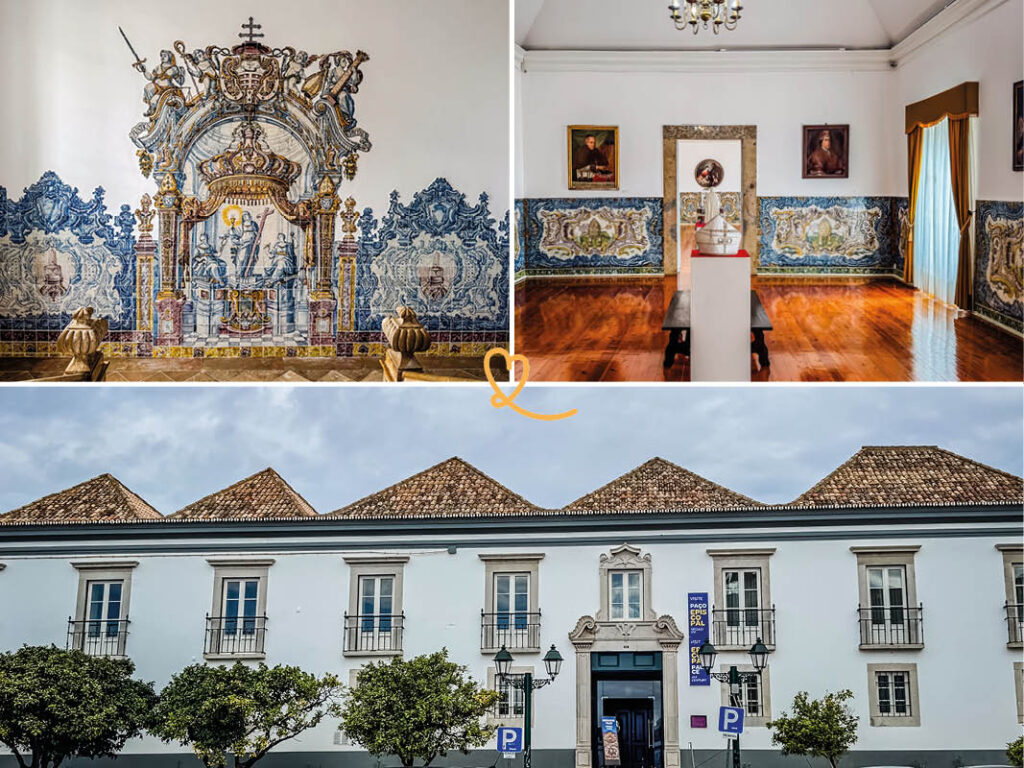Visiting Faro? Don’t miss the Episcopal Palace! A veritable ode to the art of azulejos, it offers a fascinating insight intoPortuguese art and culture. We enjoyed wandering through its rooms and admiring the details of the faience masterpieces that adorn its walls.
In this article, you’ll find some useful tips to help you prepare for your visit and have a wonderful time!

This opinion is completely independent, based on our experiences. We visited the region anonymously, making our own choices and paying our bills in full.
Why visit Faro’s Episcopal Palace?
Is Faro’s Paço Episcopal worth it? Our opinion:
Absolutely! We were won over by the historical and artistic richness of this place. The splendor of the azulejos left a lasting impression on us, and in our opinion this isone of Faro’s must-sees! We highly recommend a visit to this architectural gem. All the more so as it’s quick and inexpensive to explore, making it an easy addition to your tour itinerary and offering a fascinating insight into Portuguese art and culture.

Our favorite moments
- Our visit was marked by ouramazement at the Allegory of Charity, the majestic azulejo composition that greeted us on the palace staircase.
- Discovery of the Salle de l’Unité: the richness and complexity of the azulejos in this room, with their vibrant colors, left a deep impression on us. The overflowing fantasy of this rococo composition struck us as a true masterpiece!
If you’d like to find out more about Faro, its history and architecture, here are our ideas for activities to explore the city:
- Enjoy a guided bike tour of Faro and discover the city’s history – see activity details
- Do you have a sweet tooth? Opt for a guided tour of Faro with food tour included! – see activity details

History in brief
We learned that the history of Faro’s Paço Episcopal was marked by the transfer of the episcopal see from Silves to Faro in 1577, a turning point for the city. Construction of the palace began in 1585, under the episcopacy of D. Afonso Castel-Branco, to serve as the bishop’s official residence and as a college for the training of priests. After the earthquake of 1755, it was rebuilt and enlarged, occupying an important place in what is now Faro’s old town. Over the centuries, we have discovered that the building has undergone several phases of change and restoration, most notably in the 20th century, and most recently between 2004 and 2005. Today, Faro’s Paço Episcopal is one of the Algarve’s most representative examples of Portuguese “Chão” style architecture from this period.

WHERE TO STAY IN Faro
Our favorites: neighborhoods and hotels
Best apartment hotel
Amália Boutique Suites & Studios – See prices, photos and availability
Best boutique-hotel
Roots Hotel – See prices, photos and availability
Best luxury hotel
3HB Faro – See prices, photos and availability

Access: Episcopal Palace, Faro
Where is Paço Episcopal de Faro?
Faro’s Episcopal Palace is located in Faro’s Largo da Sé square:
- In Faro’s old town
- Less than a 5-minute walk from the Municipal Museum and Faro Cathedral
- Close to must-see places in the Algarve capital

How to get there?
There are several options for getting to Faro’s Episcopal Palace:
- The building is easily accessible on foot.
- If you take public transport, the Rodoviário Terminal stop on the city’s transport network is the nearest. To plan your itinerary, please consult the route maps, timetables and fares here.
- You can choose a sightseeing bus tour. Hop-on-hop-off buses are a great way to visit all the sights quickly and easily. Book your Hop-On-Hop-Off pass now.

Parking
There is no on-site parking available. The nearest covered parking lot is the “Saba da Pontinha” parking lot, about a 10-minute walk from the palace. Alternatively, discover all our tips for parking in Faro.

OUR ADVICE FOR RENTING A CAR IN THE Algarve
- Compare prices on our preferred platform: DiscoverCars – one of the best rated sites.
- Don’t take a car that’s too wide, as old towns have narrow streets and small parking spaces.
- For more choice, book early.

Read our tips (coming soon)
Useful tips: duration, schedules, eating…
Best time to visit
We advise you to come as soon as it opens, so you can enjoy the rooms in complete peace of mind. Note, however, that the Paço Episcopal de Faro is generally not very busy, so you can visit at a time that suits you best.
Length of visit and main difficulties
Allow 30 minutes for the visit.
Faro’s Episcopal Palace has many staircases, with no alternative, making it difficult to access for people with reduced mobility.

Advice on how to visit
There’s only one way to visit Faro’s Episcopal Palace. As you enter the building, after stopping at the ticket office, turn left and take the stairs. Once upstairs, you’ll discover the Salle de l’Unité, the Galerie des Évêques and the Salle du Trône. You will then return to the first floor.

Schedules and rates
Opening hours: Monday to Saturday, 10 a.m. to 1 p.m. and 2 p.m. to 6 p.m.
Price: €2.50
Read the latest news here.

Catering
There are no catering facilities on site. On the other hand, you’re right in the center of town, close to a wide range of establishments. Discover our favorite restaurants in Faro, to enjoy before or after your visit.

Start of the tour: discover the architecture and azulejos of the Palace

Arriving at Faro’s Paço Episcopal, we were immediately struck by its imposing façade. Built in 1585 following the transfer of the episcopal see from Silves to Faro, this palace embodies the new importance of the Algarve capital. Its sober yet elegant architecture is typical of the Portuguese “Chão” style. Faro’s Paço Episcopal is considered one of the most important examples of this style in the Algarve!
Are you familiar with this type of architecture? It is distinguished by the austerity and sobriety of its forms: straight lines, geometry, little decoration, compact and orthogonal volumes… We also learned that the Episcopal Palace is distinguished by its 7 4-sloped roofs!

Passing through its imposing entrance, you’ll enter the interior and discover a veritable treasure trove of 18th-century azulejos. These tiles adorn every corner of the building, testifying to the artistic richness of the Baroque period. You’ll no doubt be impressed, as we were, by the Panel of Virtues on the staircase. An allegory of Charity, alluding to Prudence’s 5 virtues (faith, hope, justice and strength), is depicted. This first panel of azulejos is a good introduction to the works that await you during the rest of your visit.

A LITTLE MORE patience
All the photos, maps, information and addresses you need to make your stay in Portugal a success will soon be available in a single ebook!
If you would like to be informed when our guide to Portugal is published, please register:

Continuation of the tour: discovery of the Palace’s most remarkable Azulejos, in the Hall of Unity.

The Salle de l’Unité particularly impressed us with its rich azulejos, considered to be the most precious in the palace! This room, formerly an anteroom, expresses through its works the desire to reaffirm the communion of the Algarve diocese with the Pope of the time, in a turbulent context. We loved its hushed, baroque ambience. Here you’ll discover 7 panels of azulejos, whose main colors are yellow, almost golden, and blue.

We noticed that each composition is centered on a shield in the center, surrounded by episcopal symbols such as the miter, the crozier or the lighted torch. During our visit, we learned that the most important sign is the one on the wall to the left of the entrance. However, we liked all the compositions and took great pleasure in scrutinizing every detail, trying to understand the meaning of the story told by this earthenware fresco.
Visit the Galerie des Évêques: portraits and religious objects in a baroque setting

We continued our exploration by entering the Galerie des Évêques. This former reception hall is now dedicated to paying tribute to the ecclesiastical history of the Algarve through the centuries. Here you’ll find polychrome azulejos with repetitive Baroque motifs, dominated by acanthus leaves and scrolls. We found that these tiles, in shades of white, blue, yellow and green, went harmoniously with the decor of this space.

The Galerie des Évêques features portraits of the prelates. Representations of the most important figures in the history of Faro’s Episcopal Palace are on display. Arranged chronologically, they tell the story of the diocese. If you’re interested in the ecclesiastical history of the Algarve, you’ll probably notice the portrait of D. Frei Lourenço de Santa Maria, a central figure in the palace’s history.
Subscribe to our Newsletter
- Get away from it all with Region Lovers’ beautiful destinations!
- Once a month
- Advertising-free
End of the tour in the former throne room: azulejos & sacred art

Our visit ended in the former Salle du Trône, a place imbued with solemnity. Here you’ll admire azulejo panelling from the Rococo period, with a chromatic palette reminiscent of the previous room. In the center, the coat of arms of Bishop D. Frei Lourenço de Santa Maria stands out, once again underlining his prominent role in the palace’s history.

This room also displays paintings from the Paço Episcopal ‘s collection of sacred art and a few statuettes. As we left, we felt the historical and spiritual richness of this place. Here you can contemplate the harmonious alliance between the decorative art of azulejos and sacred art, a reflection of Portuguese faith and culture through the centuries.
PLAN YOUR TRIP TO THE algarve
- Best of
Things to do in the Algarve
Most beautiful landscapes (coming soon)
Most beautiful towns and villages (coming soon)
Algarve’s most beautiful beaches

- Practical advice
When to go? (coming soon)
How to rent a car in the Algarve (coming soon)
Driving tips (coming soon)
Itineraries (coming soon)

- The must-dos
Ponta da Piedade (coming soon)
Benagil cave (coming soon)
Praia da Marinha
Dolphin watching (coming soon)
What to do in Lagos
What to do in Portimao
What to do in Albufeira
What to do in Faro





